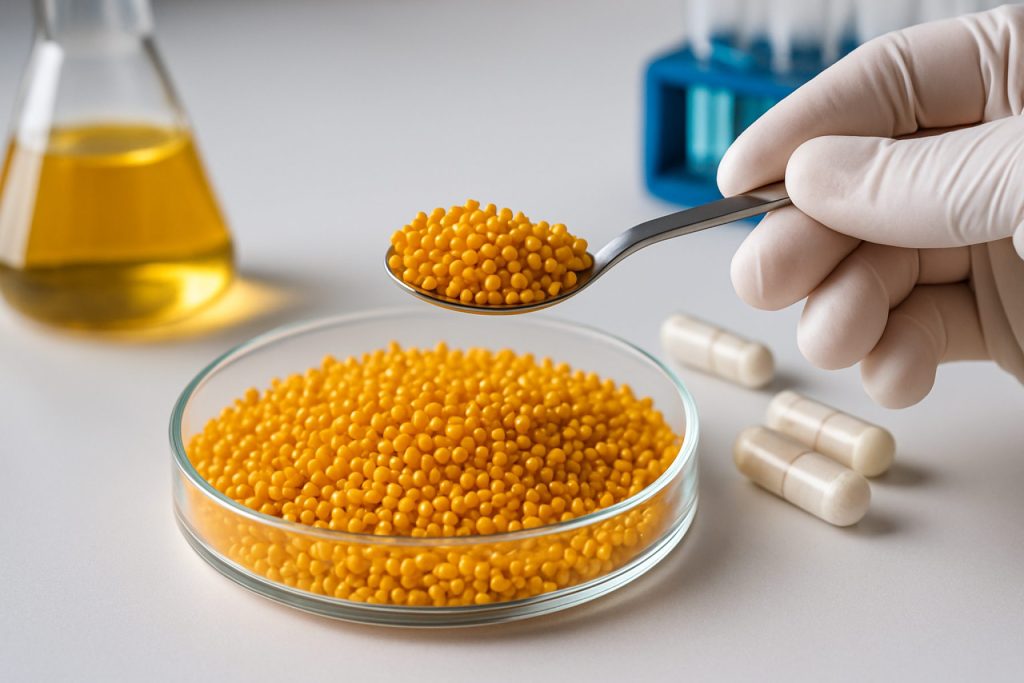
Nutraceutical Microencapsulation Technologies Market Report 2025: In-Depth Analysis of Growth Drivers, Innovations, and Global Opportunities. Explore Market Size, Leading Players, and Future Trends Shaping the Industry.
- Executive Summary & Market Overview
- Key Technology Trends in Nutraceutical Microencapsulation
- Competitive Landscape and Leading Players
- Market Growth Forecasts (2025–2030): CAGR, Revenue, and Volume Analysis
- Regional Market Analysis: North America, Europe, Asia-Pacific, and Rest of World
- Challenges and Opportunities in Microencapsulation for Nutraceuticals
- Future Outlook: Emerging Applications and Strategic Recommendations
- Sources & References
Executive Summary & Market Overview
Nutraceutical microencapsulation technologies refer to advanced processes that enclose bioactive compounds—such as vitamins, minerals, probiotics, and plant extracts—within protective coatings at the microscopic level. This technique enhances the stability, bioavailability, and controlled release of nutraceutical ingredients, addressing key challenges in product formulation and delivery. As consumer demand for functional foods and dietary supplements continues to surge, the global market for nutraceutical microencapsulation technologies is experiencing robust growth.
In 2025, the nutraceutical microencapsulation market is projected to reach new heights, driven by innovation in encapsulation materials, rising health awareness, and the expansion of functional food categories. According to Grand View Research, the global microencapsulation market—encompassing nutraceutical applications—was valued at over USD 10 billion in 2023 and is expected to register a compound annual growth rate (CAGR) of approximately 13% through 2030. The nutraceutical segment is a significant contributor, propelled by the need to mask unpleasant tastes, protect sensitive ingredients from environmental degradation, and enable targeted delivery within the digestive tract.
Key industry players, including Givaudan, Balchem Corporation, and DuPont, are investing heavily in research and development to refine encapsulation techniques such as spray drying, coacervation, and liposomal delivery. These advancements are enabling the incorporation of a wider range of bioactives into food matrices without compromising sensory qualities or shelf life. Additionally, regulatory agencies like the U.S. Food and Drug Administration (FDA) and the European Food Safety Authority (EFSA) are providing clearer guidelines for the use of encapsulated ingredients, further supporting market expansion.
- Functional beverages and fortified snacks are among the fastest-growing application areas, as manufacturers seek to differentiate products with added health benefits.
- Consumer preference for clean-label and plant-based encapsulation materials is influencing R&D priorities and ingredient sourcing.
- Asia-Pacific is emerging as a high-growth region, fueled by rising disposable incomes and increasing adoption of Western dietary patterns.
Overall, nutraceutical microencapsulation technologies are poised to play a pivotal role in the evolution of the global health and wellness industry in 2025, offering solutions that align with both consumer expectations and regulatory requirements.
Key Technology Trends in Nutraceutical Microencapsulation
Nutraceutical microencapsulation technologies are rapidly evolving, driven by the demand for enhanced stability, targeted delivery, and improved bioavailability of functional ingredients in food, dietary supplements, and beverages. As of 2025, several key technology trends are shaping the landscape of microencapsulation in the nutraceutical sector.
- Advanced Encapsulation Materials: There is a marked shift toward the use of novel biopolymers and natural materials, such as alginates, chitosan, and modified starches, which offer improved compatibility with active nutraceutical compounds and meet clean-label requirements. These materials provide better protection against oxidation, moisture, and gastric degradation, ensuring the integrity of sensitive ingredients like probiotics, omega-3 fatty acids, and polyphenols (DSM).
- Precision Release Mechanisms: Technologies enabling controlled and targeted release are gaining traction. Innovations such as pH-sensitive coatings and multi-layer encapsulation allow for the timed release of actives in specific regions of the gastrointestinal tract, maximizing efficacy and minimizing side effects. This is particularly relevant for ingredients that are unstable in the stomach but effective in the intestine (Balchem).
- Spray Drying and Spray Chilling Advances: While spray drying remains a dominant technique due to its scalability and cost-effectiveness, recent advancements focus on optimizing process parameters to reduce thermal degradation of heat-sensitive nutraceuticals. Spray chilling, which uses lower temperatures, is increasingly adopted for encapsulating lipophilic and volatile compounds (MarketsandMarkets).
- Emulsion-Based and Liposomal Encapsulation: Emulsion-based systems, including nanoemulsions and liposomes, are being refined to enhance the solubility and absorption of poorly water-soluble nutraceuticals. Liposomal encapsulation, in particular, is recognized for its ability to improve the bioavailability of vitamins, minerals, and botanical extracts (Glanbia Nutritionals).
- Personalized Nutrition and Smart Encapsulation: The integration of microencapsulation with digital health and personalized nutrition platforms is an emerging trend. Smart encapsulation systems are being developed to respond to individual physiological cues, such as enzyme levels or microbiome composition, for truly personalized nutraceutical delivery (Frost & Sullivan).
These technology trends are expected to drive innovation and differentiation in the nutraceutical market, supporting the development of next-generation products with superior efficacy, stability, and consumer appeal.
Competitive Landscape and Leading Players
The competitive landscape of the nutraceutical microencapsulation technologies market in 2025 is characterized by a dynamic mix of established multinational ingredient suppliers, specialized technology providers, and innovative startups. The sector is witnessing intensified competition as companies strive to differentiate their offerings through advanced encapsulation techniques, improved bioavailability, and tailored release profiles for functional ingredients.
Key players dominating the market include Givaudan, International Flavors & Fragrances (IFF), Balchem Corporation, and DuPont Nutrition & Health (now part of IFF). These companies leverage robust R&D capabilities and global distribution networks to maintain their leadership. Their strategies focus on expanding patent portfolios, forming strategic partnerships with food and beverage manufacturers, and investing in next-generation encapsulation platforms such as liposomal, spray-drying, and coacervation technologies.
Emerging players and technology specialists, such as AVEKA Group and Capsulae, are gaining traction by offering customized microencapsulation solutions for probiotics, omega-3 fatty acids, and plant-based actives. These firms often collaborate with academic institutions and nutraceutical brands to accelerate innovation and address specific formulation challenges, such as stability under processing conditions and targeted intestinal release.
The market is also witnessing increased activity from contract development and manufacturing organizations (CDMOs) like Sirion Biotech and SpheriTech, which provide end-to-end encapsulation services, from pilot-scale development to commercial production. This trend is particularly pronounced among smaller nutraceutical brands seeking to outsource complex encapsulation processes.
- Innovation Focus: Leading players are investing in encapsulation materials such as alginates, chitosan, and modified starches to enhance ingredient protection and controlled release.
- Geographic Expansion: Companies are expanding manufacturing footprints in Asia-Pacific and Latin America to tap into growing demand for functional foods and dietary supplements.
- Regulatory Compliance: Adherence to evolving food safety and labeling regulations is a key differentiator, with top firms proactively engaging with authorities like the European Food Safety Authority (EFSA) and the U.S. Food and Drug Administration (FDA).
Overall, the competitive landscape in 2025 is marked by rapid technological advancements, strategic collaborations, and a strong emphasis on customization to meet the evolving needs of the global nutraceutical industry.
Market Growth Forecasts (2025–2030): CAGR, Revenue, and Volume Analysis
The global market for nutraceutical microencapsulation technologies is poised for robust growth between 2025 and 2030, driven by increasing demand for functional foods, dietary supplements, and enhanced bioavailability of active ingredients. According to projections by Grand View Research, the overall microencapsulation market is expected to register a compound annual growth rate (CAGR) of approximately 13% during this period, with the nutraceutical segment representing a significant share due to its rapid adoption in food and supplement applications.
Revenue forecasts indicate that the nutraceutical microencapsulation segment will surpass USD 4.5 billion by 2030, up from an estimated USD 2.1 billion in 2025. This growth is attributed to the rising consumer preference for health-promoting products and the need for improved stability, controlled release, and masking of unpleasant flavors in nutraceutical formulations. The Asia-Pacific region, led by China, India, and Japan, is anticipated to exhibit the fastest growth, with a projected CAGR exceeding 15%, fueled by expanding middle-class populations and increasing health awareness (MarketsandMarkets).
Volume analysis reveals that the adoption of microencapsulated nutraceutical ingredients—such as vitamins, minerals, probiotics, and omega-3 fatty acids—will see a marked increase. By 2030, the annual volume of microencapsulated nutraceuticals is expected to reach over 250 kilotons globally, compared to approximately 120 kilotons in 2025. This surge is supported by technological advancements in encapsulation methods, including spray drying, coacervation, and fluidized bed coating, which enhance ingredient stability and enable innovative product development (Fortune Business Insights).
- CAGR (2025–2030): 13% (global average), with higher rates in Asia-Pacific.
- Revenue (2030): USD 4.5+ billion for nutraceutical applications.
- Volume (2030): 250+ kilotons of microencapsulated nutraceutical ingredients.
In summary, the nutraceutical microencapsulation technologies market is set for dynamic expansion through 2030, underpinned by consumer trends, technological innovation, and regional market developments. Companies investing in advanced encapsulation solutions are well-positioned to capitalize on this growth trajectory.
Regional Market Analysis: North America, Europe, Asia-Pacific, and Rest of World
The global nutraceutical microencapsulation technologies market exhibits distinct regional dynamics, shaped by regulatory frameworks, consumer preferences, and innovation ecosystems. In 2025, North America, Europe, Asia-Pacific, and the Rest of the World (RoW) each present unique growth trajectories and challenges for industry stakeholders.
- North America: The North American market, led by the United States, remains at the forefront of nutraceutical microencapsulation innovation. High consumer demand for functional foods and dietary supplements, coupled with a robust R&D infrastructure, drives adoption of advanced encapsulation techniques such as spray drying, coacervation, and liposomal delivery. Regulatory clarity from agencies like the U.S. Food and Drug Administration supports product development, while partnerships between food manufacturers and technology providers accelerate commercialization. The region’s market is further bolstered by a strong focus on personalized nutrition and clean-label trends.
- Europe: Europe’s nutraceutical microencapsulation sector is characterized by stringent regulatory standards set by the European Food Safety Authority and a mature functional food market. Countries such as Germany, France, and the UK are key contributors, with a focus on encapsulating probiotics, omega-3 fatty acids, and plant-based bioactives. Sustainability is a major driver, prompting the adoption of biodegradable encapsulation materials and green processing methods. The region also benefits from strong academic-industry collaborations, fostering innovation in encapsulation efficiency and controlled release.
- Asia-Pacific: The Asia-Pacific region is experiencing the fastest growth, propelled by rising health awareness, expanding middle-class populations, and increasing investments in food technology. Major markets like China, Japan, and India are witnessing rapid adoption of microencapsulation to enhance the stability and bioavailability of traditional and novel nutraceutical ingredients. Local companies are leveraging cost-effective manufacturing and government support for food innovation. However, regulatory harmonization remains a challenge, with varying standards across countries.
- Rest of World (RoW): In Latin America, the Middle East, and Africa, the market is emerging, driven by urbanization and growing demand for fortified foods. Brazil and South Africa are notable early adopters, focusing on encapsulation for vitamins and minerals. Market expansion is tempered by limited technical expertise and infrastructure, but international collaborations and technology transfer initiatives are gradually bridging these gaps.
Overall, regional market analysis reveals that while North America and Europe lead in technological sophistication and regulatory maturity, Asia-Pacific is the primary engine of volume growth, and RoW regions represent untapped potential for future expansion. Strategic localization and regulatory navigation will be critical for companies seeking to capitalize on these diverse regional opportunities in 2025.
Challenges and Opportunities in Microencapsulation for Nutraceuticals
The microencapsulation of nutraceuticals—bioactive compounds that provide health benefits beyond basic nutrition—has become a pivotal technology in the functional food and dietary supplement industries. As of 2025, the sector faces a dynamic landscape marked by both significant challenges and promising opportunities.
One of the primary challenges is the selection of appropriate encapsulation materials and methods to ensure the stability, bioavailability, and controlled release of sensitive nutraceutical ingredients. Many nutraceuticals, such as polyphenols, omega-3 fatty acids, and probiotics, are highly susceptible to degradation from environmental factors like heat, light, and oxygen. Achieving effective protection without compromising the release profile or sensory attributes of the final product remains a technical hurdle. For instance, while spray drying is widely used for its scalability and cost-effectiveness, it may not be suitable for heat-sensitive compounds, prompting the exploration of alternative techniques such as freeze-drying, coacervation, and liposomal encapsulation Mordor Intelligence.
Regulatory compliance and consumer acceptance also present ongoing challenges. The use of novel encapsulation materials, especially those derived from synthetic or genetically modified sources, is subject to stringent regulatory scrutiny in key markets such as the European Union and North America. Additionally, there is a growing consumer demand for clean-label and plant-based ingredients, which limits the choice of encapsulants and necessitates innovation in natural polymers and biopolymers Grand View Research.
Despite these challenges, the market is rife with opportunities. Advances in nanotechnology and smart delivery systems are enabling the development of microcapsules with enhanced targeting and release capabilities, opening new avenues for personalized nutrition and precision health applications. The integration of artificial intelligence and machine learning in formulation design is accelerating the optimization of encapsulation processes, reducing time-to-market for new products MarketsandMarkets.
- Growing demand for fortified foods and beverages is expanding the application scope for microencapsulated nutraceuticals.
- Collaborations between ingredient suppliers, technology providers, and food manufacturers are fostering innovation and scaling up production capabilities.
- Emerging markets in Asia-Pacific and Latin America are witnessing increased investments, driven by rising health awareness and disposable incomes.
In summary, while technical, regulatory, and consumer-related challenges persist, the nutraceutical microencapsulation sector in 2025 is characterized by robust innovation and expanding commercial opportunities, positioning it as a key enabler in the future of functional nutrition.
Future Outlook: Emerging Applications and Strategic Recommendations
The future outlook for nutraceutical microencapsulation technologies in 2025 is shaped by rapid advancements in encapsulation materials, delivery systems, and a growing demand for functional foods and personalized nutrition. As consumer awareness of health and wellness continues to rise, the nutraceutical industry is increasingly leveraging microencapsulation to enhance the stability, bioavailability, and controlled release of active ingredients such as probiotics, vitamins, minerals, and plant extracts.
Emerging applications are expected to focus on precision nutrition, where microencapsulated nutraceuticals are tailored to individual health profiles. This trend is supported by the integration of digital health tools and wearable devices, enabling real-time monitoring and personalized supplementation. Additionally, the food and beverage sector is anticipated to adopt microencapsulation for fortifying products without compromising taste, texture, or shelf life, addressing the challenge of incorporating sensitive bioactives into mainstream products.
Technological innovations are driving the development of novel encapsulation materials, such as biopolymers and lipid-based carriers, which offer improved protection and targeted delivery. The use of natural, clean-label encapsulants aligns with consumer preferences and regulatory trends, particularly in North America and Europe. Furthermore, advances in nanoencapsulation and multilayer encapsulation are opening new possibilities for multi-functional delivery systems, enabling the co-encapsulation of synergistic ingredients and sequential release profiles.
Strategic recommendations for stakeholders in 2025 include:
- Investment in R&D: Companies should prioritize research into advanced encapsulation techniques and materials, focusing on scalability, cost-effectiveness, and regulatory compliance.
- Collaboration Across the Value Chain: Partnerships between ingredient suppliers, food manufacturers, and technology providers can accelerate innovation and facilitate the integration of microencapsulated nutraceuticals into diverse product categories.
- Regulatory Alignment: Staying abreast of evolving regulations regarding encapsulation materials and health claims is critical, especially as authorities such as the European Food Safety Authority and U.S. Food and Drug Administration increase scrutiny of novel food technologies.
- Consumer Education: Transparent communication about the benefits and safety of microencapsulated ingredients can build trust and drive adoption among health-conscious consumers.
According to MarketsandMarkets, the global microencapsulation market is projected to reach USD 16.8 billion by 2027, with nutraceuticals representing a significant growth segment. Companies that strategically invest in emerging applications and align with market and regulatory trends are well-positioned to capitalize on the expanding opportunities in 2025 and beyond.
Sources & References
- Grand View Research
- Givaudan
- Balchem Corporation
- DuPont
- European Food Safety Authority (EFSA)
- DSM
- MarketsandMarkets
- Glanbia Nutritionals
- Frost & Sullivan
- AVEKA Group
- Fortune Business Insights
- Mordor Intelligence



